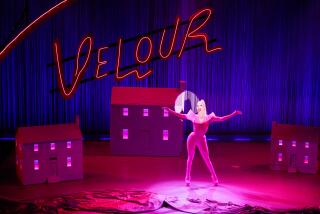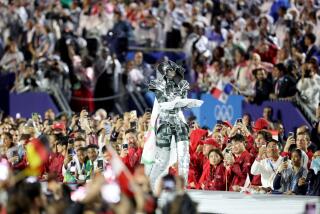Dance festival keeps focus on the fringes
MONTE CARLO — It’s arguably the world’s most ambitious and visionary dance festival, but it receives relatively little attention in the United States. The biennial Monaco Dance Forum, held in the exclusive European principality, focuses on a low-profit performing art and is conducted largely in French. But the young festival is broader in scope than prominent performance-oriented gatherings such as the American Dance Festival and Jacob’s Pillow, and focuses squarely on what it perceives as the brave frontiers of dance creation and presentation.
This year’s festival, the longest yet, began Dec. 7 at the recently restored Monte Carlo Opera House, with the fourth Nijinsky Awards. It ends today.
The festival was previously housed almost entirely within the enormous and ultramodern Grimaldi Forum. With the support of the Societe des Bains de Mer, the 2006 edition was spread across multiple venues in and around Monte Carlo -- including the salons of grand hotels, numerous area theaters and unexpected outdoor locations -- as part of what Artistic and General Director Dominique Passet called an effort to “move the work closer to the public and frame it in a way that makes the public curious and open to seeing dance in a fresh light.”
Co-founded in 2000 by Princess Caroline of Monaco; Jean-Christophe Maillot, artistic director of Les Ballets de Monte-Carlo; and Stephane Martin, former president of the Grimaldi Forum, the forum’s dizzying array of programming has evolved to reflect changing perspectives and priorities. Gone were the extensive film screenings of earlier editions, but new interests were explored, such as interactive installations and dance in public spaces. Two-day conferences within the festival looked at dance and memory and dance pedagogy and medicine.
But, as in 2004, the greatest emphasis was the increasingly widespread integration of interactive digital media with all idioms of dance, along with the growing prevalence of genre fusions. “The technological development is such a fluid moving target that the performances we see here are the futures of three years ago; that’s how long it takes to develop these pieces,” said composer-media artist Mark Coniglio, 45, of New York. The L.A. transplant is half of the 12-year-old Troika Ranch dance group and author of the software Isadora, which translates dance movement into real-time audio-visual output.
But the promise of interactive media and genre fusion to expand artistic potential comes at the peril of misuse or overuse. In Monaco, artists from France, Algeria, the U.S., Burkina Faso, Canada, Finland, India, Mozambique, New Caledonia, Spain, Sri Lanka and beyond showcased the current trends in works that varied from naive to entertaining, pretentious to profound. “We shouldn’t imagine that digital tools alone are the future of dance. They’re just one small part of it,” said Maillot.
Arguably the richest blend of new media and dance at this year’s forum came from the Paris-based Spaniard Anna Ventura. Her ambitious 100-minute work “D’Annachronique ... Pavlova Moi,” performed Sunday at the Opera House, seamlessly integrated nearly nonstop floor-to-ceiling multimedia effects with creative movement to produce a compellingly atmospheric and occasionally hilarious -- though overlong and meandering -- marathon solo hommage to legendary ballerina Anna Pavlova’s “Dying Swan.”
Of the many performances that stressed the fusion of dance styles, some were disappointingly weak and superficial. But two showed hip-hop movement integrated so seamlessly into performance that it seemed not a recent urban American development but a classical, timeless vocabulary compatible with the harmonies and rhythms of diverse cultures. Sunday in the Salle Empire of the Hotel de Paris, Algerian soloist Ahmed Khemis performed “Le Voyage de Poussieres” to Sufi music. And Wednesday afternoon, Najib Guerfi’s ensemble, from France and New Caledonia, presented “Les Damnes,” which tackled Faust just as the group treated Orpheus at the 2004 festival.
Wednesday evening, American icon Bill T. Jones, as much sage elder as dancer, gave one of the festival’s most moving and effective performances. In the European premiere of his solo “22,” movement, spoken word, music and projection intimately linked in service of emotion, spirit and moral reflection on caring for the next generation.
On the same bill, Trisha Brown’s “How Long Does the Subject Linger on the Edge of the Volume” featured an early step by U.S. researcher Marc Downie toward what Coniglio described as the extreme cutting-edge of multimedia technology: artificial intelligence that goes beyond mapping dance movement in three dimensions to sense essential qualities (such as “lyricism”) in the same way that humans do, in order to drive multimedia effects with “intelligent persistent reaction,” or the potential for surprise and “true digital partnering.”
The abstract projections in Brown’s spare postmodern ensemble work seemed a virtual dancing element -- with life and expressiveness independent of, but clearly related to, the human performers.
In the end, one of the most surprising and profound works seen in Monaco featured a dancer interacting with pre-digital industrial technology. “Transports Exceptionnels,” choreographed by Dominique Boivin of French group Beau Geste, is a 20-minute duet for a dancer and a mechanical shovel that was performed twice on a seaport dike.
The delightfully elegant and dignified duet suggested courtship, conflict, tenderness, heartache, and heroism. The inspired choreography, plus the talents of dancer Philippe Priasso and driver Eric Lamy, endowed the shovel with human qualities as it lifted, lowered, and spun with Priasso dodging, hanging from, cradled within, or standing atop it. When the shovel knocked the ground, it seemed an emotional outburst, and viewers were left questioning who held the power in the relationship.
Said Maillot, “I almost cried as I watched it. For me, this pas de deux on the harbor was the biggest discovery, and the real answer to the relationship between man and technology. The dancer disciplined the machine, took it over and made me believe that the shovel had eyes and heart and could fall in love with him.
“As long as I see performances like this, I will believe in dance.”
More to Read
The biggest entertainment stories
Get our big stories about Hollywood, film, television, music, arts, culture and more right in your inbox as soon as they publish.
You may occasionally receive promotional content from the Los Angeles Times.










